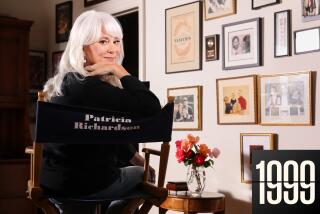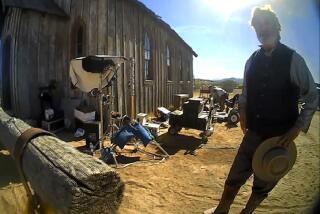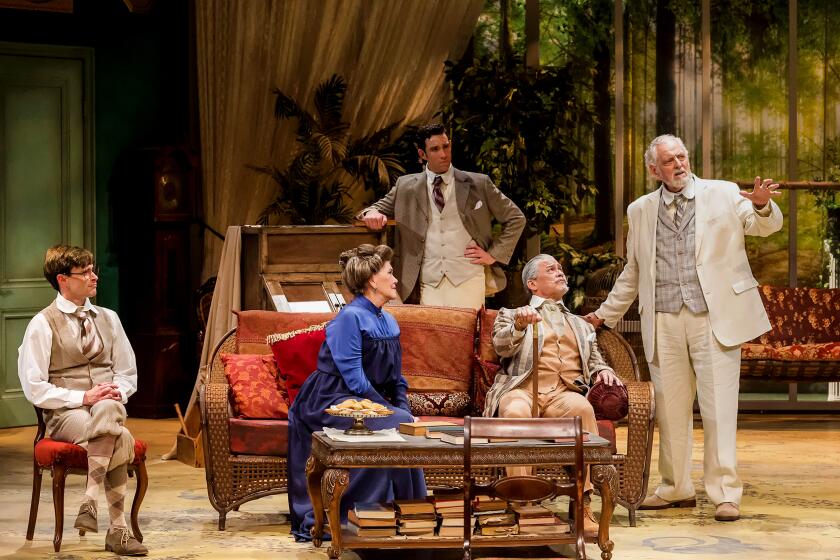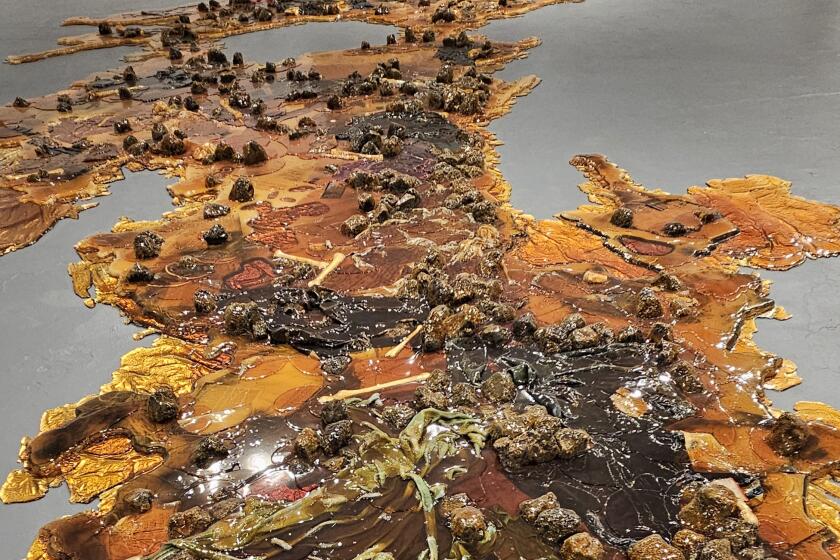Designing a Painterly, New ‘Swan Lake’ : Baryshnikov and Samaritani re-create a ballet for American Ballet Theatre
History tells us that Marius Petipa, the mastermind behind the production that made “Swan Lake” more synonymous with ballet than any other single work, plotted his choreography in the mid-1890s by toying with groups of figurines on a table top.
Something akin to this occurred recently when Italian designer PierLuigi Samaritani worked with Mikhail Baryshnikov on the new American Ballet Theatre production of “Swan Lake,” which will receive its world premiere Friday at the Orange County Performing Arts Center.
Samaritani, who has designed sets and costumes for opera for two decades, had previously designed only a few ballets, namely “Le Baiser de la Fee” and “The Nutcracker” in Florence. But he is already familiar to Ballet Theatre audiences for his highly acclaimed scenic contribution to Natalia Makarova’s 1980 production of “La Bayadere,” another of the 19th-Century classics to Petipa’s credit.
Schedule conflicts prevented other planned projects with Baryshnikov from taking place--for example, Ballet Theatre’s 1981 staging of Balanchine’s “La Sonnambula” and Baryshnikov’s own production of “Cinderella” in 1983.
“He likes talking about ‘weapons,’ ” Baryshnikov said recently in an interview discussing Samaritani’s input on the “Swan Lake” project. In each of the ballet’s four acts Baryshnikov noted Samaritani’s saying “the weapon is . . . “ in reference to some intended visual detail that would function with theatrical force.
Samaritani, who refers to himself “primarily as a painter, and a scenographer too,” sees this “Swan Lake” as a “pictorial concept,” he said in a separate interview. By this he means painted decor as opposed to built or constructed scenery. “Because it is necessary to leave all the space for the dance, I think the painted way is the best for the ballet,” he said, acknowledging that this was Baryshnikov’s idea as well.
To Baryshnikov, Samaritani’s design concept is essentially “three different acts, in color and in atmosphere.” (According to the ballet’s four-act scheme, Acts II and IV are set in the same locale, the lakeside.) The first act, in which Prince Siegfried and his favorite subjects meet to celebrate his coming of age, is here set as a forest scene and is “much less conventional” than usual, Baryshnikov suggested, noting its dominant color--lilac.
Samaritani said he chose this unusual hue after he studied Tchaikovsky’s music by listening to recordings.
Baryshnikov recalled the designer saying, “For me, first this is a color, a kind of lilac forest, with golden sunshine.”
For Samaritani, whose aim was to create an appropriate storybook epoch, “the problem from the beginning, from the first act, is to avoid everything (specific)--the season, for example.” He believes “that the whole must be very free, so it will have the blessing of Tchaikovsky. For his fairy tale, it is impossible to place it somewhere in some time.”
The Baryshnikov/Samaritani version of “Swan Lake” replaces a staging that was Ballet Theatre’s first four-act production. Staged for the company in 1967 by David Blair of Britain’s Royal Ballet, that first full-length ABT “Swan Lake” lasted, more or less, as a Ballet Theatre staple until 1984. Baryshnikov, who became the company’s artistic director in 1980, slightly revamped this presentation in 1981.
The new staging, which gives choreography credit to Marius Petipa and Lev Ivanov, will include additional choreography by Baryshnikov himself, who is not scheduled to dance in the production.
Calling his production’s second act “straight Ivanov,” in reference to the sacrosanct traditional version seen around the world, Baryshnikov elaborated by saying that he has also retained most of Petipa’s extant choreography. This includes the dances for the pas de trois in Act I, the traditional national dances in Act III, as well as the adagio in the same act for the Prince and Odile.
“The rest?” Baryshnikov said. “Everything is completely new.” By this he means all the surrounding choreography for Act I, the variations for the leads in Act III, plus two new divertissement dances here, and the whole of Act IV.
Essentially, Baryshnikov credits the British production that gave rise to Ballet Theatre’s earlier staging (and to sundry others) as being primarily reliable for the production’s mime, of which he intends to make extensive use. Having read a wide range of “Swan Lake” literature--including Roland John Wiley and Cyril Beaumont (in English) and Alexander Demidov, Fyodor Lupokhov, Yuri Slonimsky and Vera Krasovskaya (in Russian)--Baryshnikov stated firmly: “I believe if anything was done correctly (by way of this British lineage) it was the mime. The (dance) steps? I’m convinced they’re not (correct). But the mime--it’s the easiest to learn to notate.”
His Act IV will in no way include the revisionist happy ending that has been part of all Soviet productions in Baryshnikov’s lifetime. His response to such a notion was immediate: “Are you kidding? It’s not in the music!”
As far as the lately fashionable bent toward a psychological interpretation of the narrative to focus on the Prince and his mother or his tutor, etc., Baryshnikov said, “No, I think it’s complicated enough . . . I don’t want to do anything Freudian. A lot of people have done this; probably a lot more will. I think a lot of those tries are from insecurities about the libretto (scenario), because it was changed so many times.”
However, Baryshnikov does not want to be overly specific and is still considering exactly what he wants to say in his program note: “We have to (explain something) because people will come to the theater saying, ‘Oh, but we know the story of “Swan Lake.” ’ “
No ‘Upside-Down’ View
In elaborating, however, he states flatly, “I’m not looking at this ballet upside down, but there are points I would like to express. It’s actually easier and more intriguing and more interesting than a lot of people think.”
Samaritani has designed sets and costumes for opera since 1967, working in such major European houses as Teatro alla Scala in Milan, the Paris Opera and the Teatro dell’Opera in Rome, as well as for opera houses in San Francisco, Chicago and New York.
Since 1978, he has directed as well as designed his opera projects. Of sharing the work on “Swan Lake” with Baryshnikov, he noted: “It’s easy; first, I am not a choreographer, and (Baryshnikov) had the feeling of the problems, and it’s very easy to work with him.”
He is not directly familiar with any other production of “Swan Lake” except Ballet Theatre’s previous one, which he saw only once, and suggests that his impressionistic forest in Act I in place of an autumnal clearing just outside the Prince’s palace may strike some people as unnerving, and so might his placement of a castle in the lake of Act II.
Baryshnikov notes that in the blue-green lake scenes, Acts II and IV, where the love story between the Swan Queen and her Prince begins and ends, Samaritani uses architectural detail, “in this case the ruin of a castle, instead of using it in the first act.”
For the ballroom divertissements and seduction in Act III, Samaritani chose a sort of maroon palette by covering “the whole stage, back and sides too, with tapestries” (after first considering a lavish interior defining a wealthy German country home).
Here, Samaritani said, besides an elaborate and authentic Gothic throne, he also chose some large candelabra as props, because “in this act we need quite a bright atmosphere for the beginning, so we must justify why we have a bright atmosphere.”
The two strategists of this production remain cagey during the rehearsal period in New York City about the precise nature of their most pointed theatrical weapons. Samaritani refers to his design choices as “surprises” when he speaks: “I think in the third act we’ll have a big surprise and maybe some people will be scandalized--it depends on the audience.” He sees the third act surprise mostly as Baryshnikov’s.
This will involve a special effect still being worked on at the time of these interviews. The device will allow the apparition of Odette, the Swan Queen, during the seduction of the Prince by the evil Odile in Act III. In “Swan Lake” tradition this momentary vision is usually a glimpse of a ballerina dressed like Odette. Here, it will have the appearance of a phantom in swan form.
Both Baryshnikov and Samaritani are concerned that this effect--achieved by means of shadow manipulation--be one that is clear and also “poetical,” in Samaritani’s words, and that “it shouldn’t be too naturalistic and at the same time not too cartoonish,” in Baryshnikov’s words.
The actual execution of Samaritani’s scene painting has been accomplished in Italy, in the shop of Silvano Mattei. Samaritani considers this scenic painter so crucial to a pictorial production that he once refused to take a commission because Mattei was not available.
“Mattei is the student of a great painter/scenographer Parravicini and is now the only one in that line,” Samaritani said, noting that in Europe, as in the United States, such artisans are like the “last albino elephant.”
Mattei’s shop staff is made up of more than half a dozen painters, who all worked 3 1/2 half months to create 25 hanging set pieces--various drops, scrims and borders--for “Swan Lake” (price tag: around $400,000).
For costumes, Samaritani is pleased that, as far as the swan maidens are concerned, Baryshnikov prefers the longer-skirted, Romantic-style tutus over the stiffer, so-called Classical cut, which the designer refers to as a “kind of dish.” Both men emphasize their belief that the sisterhood around the Swan Queen is not made up of waterfowl.
‘Not Swans, Not Birds’
“They’re not swans and not birds. They are young women who are possessed,” Baryshnikov said emphatically. “For ‘Swan Lake,’ the corps de ballet,” Samaritani said, “the girls--the swans--must be the symbol of the femininity, the beauty.”
Samaritani is especially concerned about the lighting of the production, which he intends to oversee. “The concept of the lighting designer,” he noted, “doesn’t exist in Europe,” where the all-important lighting plans are worked out “between the scenographer and the chief of electricians.”
The production’s most complex effect concerns the ballet’s climax in Act IV, with the double suicide of the lovers. Baryshnikov used the word Wagnerian to describe the finale’s effect, which involves the over-flooding of the lake and the collapsing of the castle.
Samaritani, who has not yet seen the proposed machinery or worked with the light, says of this effect: “I have an idea, but it must be well performed, because the dancers move (in the ballet’s apotheosis) and there must be no appearance of effort.”
Of the plan the two men worked out together for their ballet’s conclusion, Baryshnikov noted: “It’s now on the paper. I haven’t seen the machine yet. It could be very beautiful, but. . . .”
Baryshnikov said he very much liked the Performing Arts Center in Costa Mesa and called it “a perfect modern theater.” He noted that the people connected with it “were very helpful about transportation, had a night shift to hang scenery and offered more time for lighting.” But he also admitted it was “madness to try to get a four-act ballet on in two or three days--just ridiculous!”
However, perhaps drawing extra strength and confidence from his partner in art, he also said boldly: “But, still, we have to go for it.”
More to Read
The biggest entertainment stories
Get our big stories about Hollywood, film, television, music, arts, culture and more right in your inbox as soon as they publish.
You may occasionally receive promotional content from the Los Angeles Times.






